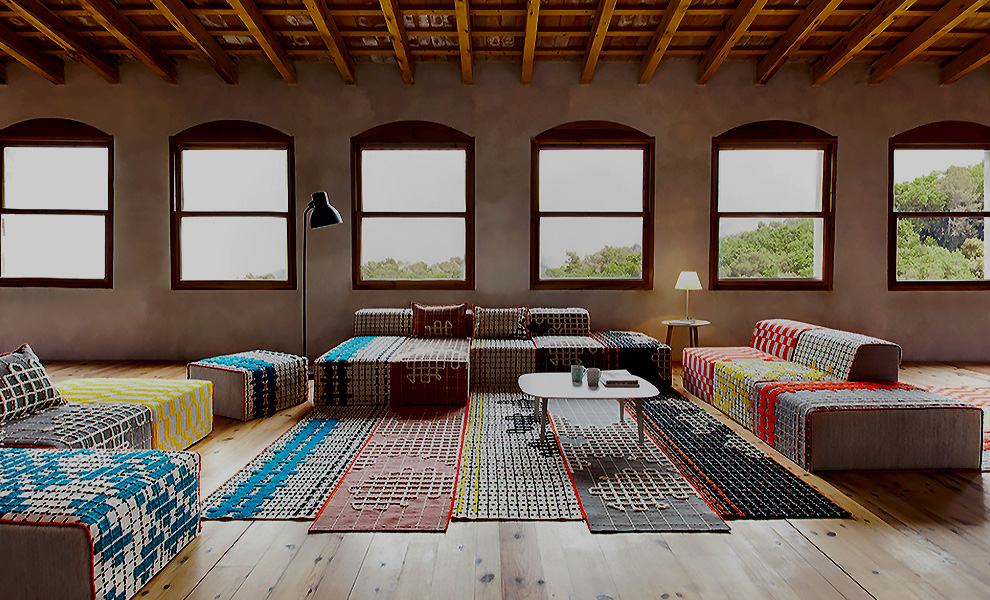A Q&A with Gan Rugs
Creative director Mapi Millet and featured designer Charlotte Lancelot
give us an inside look into how Gan Rugs' Space collection uses rich
textures and unexpected dimensions to create cozy, multi-functional spaces.
Rugs can be much more than mere floor coverings; they can come off the floor to transform entire spaces, and in a variety of different forms. It was that revelatory thought that first started and continues to fuel Gan Rugs' innovative rug, furniture and accessories concept, Space.
To find out more, we spoke with Gan Rugs Creative Director (and sometime product designer), Mapi Millet, about how both Gan Rugs and Space evolved. Millet has been a part of Gan Rugs since 2004 and, alongside company president Jose Gandia-Blasco, helped to conceive Space. Charlotte Lancelot also contributed to the conversation with her insight on the concept and her Canevas and Silai collections within the theme.
An Overview
Tell us a bit about Gan Rugs in general. How did the brand evolve from Gandia Blasco? How did you become involved with the company?
Millet's answers have been translated from Spanish.
Millet: In fact, Gan was the origin of Gandía Blasco. The initial collection that relaunched the family business was of carpets and textiles. Later, and due to the success of the outdoor furniture, carpets stayed in the background. When they began to have problems with suppliers, Jose (Gandia-Blasco), company president—and a friend of mine from the University—called me to help them in production control.
How would you summarize the Space collection?
MM: It's how a set of objects, carpets, modules and accessories can make up a complete, multipurpose and cozy space within any room in our homes.
What originally inspired the concept? Who developed it?
MM: The texture of the carpets, which was very rich. From that texture, rugs could 'grow', conquer the three dimensions and create volumes. This we proposed to Patricia Urquiola, who then designed poufs for us to complement her collection, Mangas.
Where do you anticipate Space will go next (locations of the home, patterns, textures, etc.)?
MM: What defines Gan are the ideas of the big designers converted into objects of daily use, thanks to the expert hands of craftsman around the world. Apart from that, we do not put limits. Any area of the house is good, we are interested in any activity, we explore all the time…
An Intimate Look
We got a closer look at the techniques and inspiration behind two of the Space concept's most popular iterations, Canevas and Silai, with Gan Rugs' featured designer, Charlotte Lancelot.
The Space concept of combined area rugs/furniture is very unique. As a designer, what about Space appeals most to you?
Charlotte Lancelot: When I design spaces, I strive to combine harmony with flexibility. A space should adapt to its user's lifestyle, not the opposite.
Nowadays, the "living room" concept is not reserved to home anymore; you find it in the work environment as well. It is not only a relaxation or entertainment space, but also a complete living space, where you can eat, work, chat, sleep or even practice meditation.
What I also find interesting in the evolution of furniture is that the modern rug has become a piece of furniture on its own. It is a masterpiece that defines and limits the living spaces and creates a link between the different pieces of furniture.
What inspired you in your creation of Canevas?
CL: I came up with the Canevas concept after having found beautiful perforated felt paths in the dustbin of a factory. I wanted to practice eco-design and tried to create a rug by fixing the paths together with cross-stitches. After that, I continued to improve my technique and bought several embroidery books to find more inspiration.
How did you come up with the Canevas construction technique?
CL: Simply by trying and making it! Mapi Millet also helped me a lot to produce a real product out of the project.
Congratulations on the Red Dot award (2016) for the Silai collection. Would you consider Silai an extension of the Canevas technique, or is it brand new?
CL: Thank you! It is quite the same embroidery technique, only the crosses-stitches are oversized to highlight the handmade technique. Another small difference is that the rug support is completely hidden in Silai, while it is visible in the Canevas collection. To me, the extension is clear, even if the collections are very different from an aesthetic point of view.
The Canevas collection includes ottomans, rugs and throw pillows. Silai has rugs, ottomans, tables and throw pillows. How did you decide on the necessary components for each collection?
CL: For Canevas, it was Mapi Millet who wanted to create a complete space, to give more impact to the collection.
For Silai, we followed quite the same idea. We added a table to create combinations between the several items in order to create different spaces. The low table was the missing piece to create a complete living room. What I like in these collections is that everything goes together but also separately, combined with other pieces of furniture.
Any thoughts on expanding these collections in the future?
CL: Yes, I have plenty of ideas regarding new techniques and projects! We are currently developing a new collection with Gan, based on the Canevas technique, and we also have weaving projects, a technique that is quite new to me.









